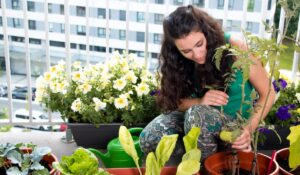Trees are living proof of the passage of time because of how majestic they are and how important they are to our ecosystems. Whether in the city or in the countryside, trees give us shade, oxygen and a connection to the beauty of nature. Caring for trees is not only a responsibility, but also an opportunity to help our world and the people who will live in it in the future. In this complete guide, we explore the most important ways to care for trees and keep them healthy and strong so they can continue to grow for years to come.
How to Care for Trees: The Basics:
Before discussing specific methods, it’s important to understand the basic rules of tree care:
Healthy Soil: Trees can only grow if the soil is healthy. The soil should be easily draining and rich in nutrients so that the roots can grow in a healthy atmosphere.
Do You Understand: Proper watering is important. Young trees need regular water to allow their roots to grow, but older trees do better with shallower water.
Use an Overlay: Placing an organic mulch around the roots will help retain moisture in the soil, keep the soil at the right temperature and keep weeds from growing.
Pruning: Pruning helps a tree grow healthily and prevents it from becoming dangerous by removing dead, diseased or overgrown branches.
Eliminate Diseases and Pests: Diseases and pests can be prevented and controlled with regular checks and the right medication.
1. Make Sure You Plant the Right Tree in the Right Place
It is very important to choose the right type of tree for your area. Consider factors such as soil type, amount of sunlight and space. Plant the trees far enough from buildings and power lines so that they grow to size. When a tree is adapted to its environment, it will grow longer and live longer.
2. How to Water Correctly
Freshly planted trees need regular water for a strong root system. Water well and thoroughly, making sure the entire root zone is moist. As your tree ages, you should change your water patterns to encourage deeper root growth. You can water the plants directly with a soaker hose or drip irrigation.
3. Mulch to Keep the Soil Moist and to Protect the Soil
Put a layer of organic soil around the base of the tree, but leave space around the trunk to avoid water problems. Mulch keeps the soil moist, prevents weeds from spreading, and prevents tree roots from getting too hot or too cold.
4. Regular Pruning
Pruning is a very important part of keeping your tree healthy and looking good. To stop the spread of disease, cut off any dead, broken, or diseased stems. Proper pruning also improves air circulation and lets more light into the plant, helping it grow faster. To ensure that the tree’s structure remains strong, hire a qualified arborist for more extensive pruning.
5. Prevention and Control of Diseases and Pests
It is very important to keep a close eye out for diseases and pests. Check trees regularly for signs of degradation, such as discolored leaves or holes in the wood. If caught early and treated right away, the damage will be reduced. Encourage insects and birds that feed on pests and reduce their numbers yourself.
6. Feed the Trees to Keep them Healthy
By testing the soil, you can find out what nutrients your tree needs. Based on the data, use a fertilizer that is balanced and releases nutrients slowly over time. Too much fertilizer can damage the tree, so follow the rules.
7. Help Young Trees
During the first years of life, young trees need extra care. The blows can help young trees remain stable in high winds and help the trunk grow straight. But don’t leave the pole too long, otherwise the trunk cannot grow properly.
8. How to Deal with Soil Compaction
If the soil is too hard, it will be difficult for the roots to grow and absorb water. If you will be walking a lot in the tree, steer clear of the root area and consider techniques such as vertical mulching or drainage to prevent compaction.
9. How to Grow Trees
In cities, trees can suffer from a lack of space and competition from buildings and other infrastructure. Prune trees smartly to maintain a balance between healthy growth and limited space.
10. Seek Help from Experts
If you’re not sure what to do or if you have serious questions about your tree, consult a licensed arborist or arborist. These experts can check the health of the tree, identify problems and suggest the right solution.
Conclusion:
Caring for trees shows how much we want to protect the natural world around us and its beauty. By learning and using basic tree care skills, we can keep these living giants growing and help make the environment healthier. Every action we take has a major impact on tree health, from the way we plant and water to how we deal with pests and improve the soil. As stewards of the land, our job is to give trees the care and attention they need, recognizing the important role they play in improving our lives and the world.
FAQs:
1. Can I plant a large tree near my house?
Planting large trees near buildings can cause future problems. Trees can damage foundations or interfere with utilities as they grow. Choose varieties that are smaller and suitable for close to buildings.
2. How often should I prune my tree?
Prune the tree as needed to remove dead or diseased branches. Inspect regularly for hazards and structural problems. Young trees may need more frequent pruning to get into proper shape.
3. Are chemical pesticides harmful to the environment?
Chemical pesticides can negatively impact the environment and non-target species. Consider an integrated pest control (IPM) approach that focuses on prevention, cultural practices, and targeted treatments.
4. Can I transplant a mature tree to a new location?
Transplanting mature trees is complex and requires careful planning. Consult a certified arborist to assess the health, root system and viability of the tree for transplant.
5. How can biodiversity around trees be promoted?
Plant different native plants around trees to create a diverse ecosystem. Native plants attract beneficial insects and birds, contributing to natural pest control and overall ecosystem health.



